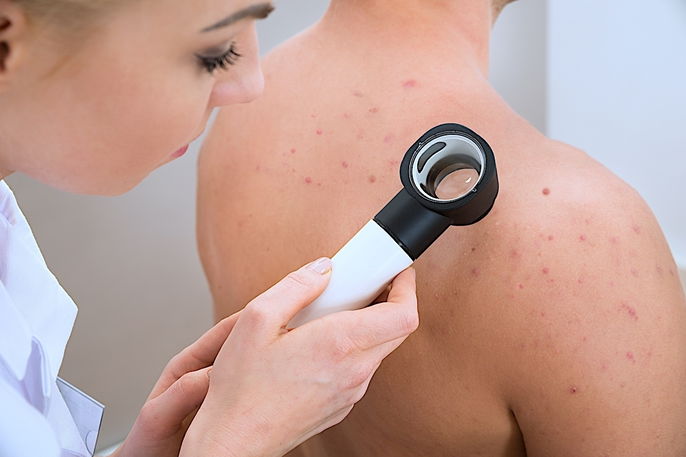What is it:
Tinea versicolor is a skin condition caused by Malassezia furfur fungus, which produces a substance called azelaic acid. This interferes with the skin‘s ability to produce melanin when exposed to the sun. In the areas of the skin where the fungus is found, the skin does not tan the same as the rest of the body, leading to the emergence of small white spots.
Generally, tinea versicolor does not cause other symptoms other than the white spots, although it can also lead to itching and flaking. The spots can increase in size over time and even appear red in color if they are not properly treated.
if you suspect you may have tinea versicolor, you should consult a dermatologist. Treatment depends on confirming a diagnosis, which will guide the use of antifungal soaps, ointments and, in serious cases, pills.

Main symptoms
The main symptoms of tinea versicolor are:
- Circular, white spots on the trunk, neck and arms
- Skin peeling or flaking over the spots
- Spots that go away after the summer.
- Itching over the spots
- Worsening of itchy during rainy or warm seasons
Although the spots caused by tinea versicolor may appear red in some cases, they are generally oval in shape and increase in size. Over time, they will combine to make larger spots.
Although this condition does not cause many symptoms, you should consult a dermatologist for assessment to initiate treatment.
Possible causes
Tinea versicolor is generally caused by a fungus called Malassezia furfur, which is naturally found on the skin, particularly in oily areas like the face, scalp and back. However, some people may be genetically predisposed to overgrowth of this fungus. Other factors that can lead to overgrowth include heat and humidity.
The risk for overgrowth of tinea versicolor is also higher during warm and humid seasons. Those who tend to sweat excessively, have low immunity, are pregnant or are teens are also at a higher risk for developing this condition.
Is it contagious?
Tinea versicolor is not considered to be a contagious disease, as these fungi are normally found in everyone’s skin and generally do not cause problems. They tend to multiply at high rates under certain conditions.
Confirming a diagnosis
Diagnosis is generally confirmed by a dermatologist, who will carefully analyze the symptoms and characteristics of the spots using a special lamp, called a Wood lamp.
The doctor may also collect a scraping of the skin to send to the lab for analysis, which can confirm the presence of the fungus and lead to a diagnosis.
Treatment options
The main ways that tinea versicolor is treated include:
1. Antifungal soaps and shampoos
Soaps and shampoos that contain selenium sulfate 2.5%, zinc pyrithione or sulfur and salicylic acid can be used to remove the outer most layer of the skin. This is where the fungus is typically found, and can be removed over time, with each layer of the skin.
2. Antifungal ointments
Antifungal ointments made of ketoconazole or terbinafine may be prescribed to destroy the fungus and interfere with further growth. These are generally used for a period of 2 to 3 weeks.
3. Oral antifungals
Antifungal medications, like itraconazole or fluconazole, are generally prescribed for cases in which the spots affect larger ares of the body, or if the fungus persists even after more using topical medications.
Nonetheless, they are generally less used, as ketoconazole, for example, can be toxic to the liver, and terbinafine may be less effective.






























